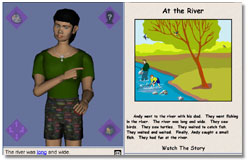 |
|
|
 |
||
|
||||||||||||||||||
|
Animated 3-D Boosts Deaf Education
|
||||||||||||||||||
|
|
|
"Andy" the avatar talks with his hands. He is a 3D animation, displaying a distinct personality and natural facial expressions that help him interpret words and phrases for hearing-disabled viewers on their computer screens.
Andy is a "signing avatar," one of a pool of Internet-enabled virtual people that translate English into sign language and help deaf and hard-of-hearing children develop language and reading skills. The SigningAvatarTM software, developed with assistance from the National Science Foundation (NSF), represents a step forward in providing universal access to technology.
"Deaf children face considerably more difficulty than hearing children learning to read," said Edwards Sims, chief technology officer of VCom3D of Orlando, Fla., which is marketing the assistive technology. "Our virtual signing interpreters help narrow that gap."
Sims and Carol Wideman developed SigningAvatarTM with grants from NSF's Small Business Innovation Research (SBIR) program. The software has been praised by teachers of the deaf and experts in computer technology for putting virtual 3D technology, widely used in video games, to use for educational purposes. SigningAvatarTM is used in several Florida school districts and at schools serving deaf students around the country.
"Lots of educational software teaches through voice communication," said Sara Nerlove, NSF's program manager. "This is one of the first compelling uses of computer animation technology to benefit an audience with hearing loss, which sometimes struggles with conventional education systems."
The characters interpret words, sentences and complicated concepts into sign language, combining signing, gestures and body language to simulate natural communication. The animations are based on in-depth research of how both hearing and deaf persons use the face and body to communicate.
The interpreters include digital teenagers with unique personalities, such as red-haired Andy and 13-year-old Tonya, and a cyber-lizard named Pete. Besides translating printed text, they "tell" stories, ask follow-up questions and hold interactive conversations with viewers. Their vocabulary includes more than 3,500 words in English and in "Conceptually Accurate Signed English," which includes elements of American Sign Language.
SigningAvatarTM technology is available on an educational CD-ROM or can be licensed to provide signing interpretation of Internet websites, including spoken information. The system uses avatars instead of videos of human signing because avatars can be downloaded faster and can interact in real time.
![]()
For more information and a demonstration of SigningAvatarTM, see http://www.signingavatar.com/
|
|
